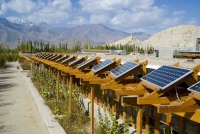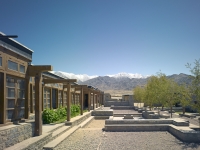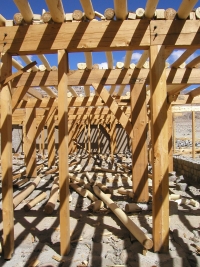When you travel by plane or by ground transportation powered by diesel or gasoline, you cause carbon dioxide (CO2) to be emitted into the atmosphere and you contribute to climate change. You can ‘offset’ this impact by investing an amount corresponding to the value of the carbon involved into a scheme elsewhere that reduces CO2 emissions. You can do this by investing in the independently-accredited Druk Padma Karpo solar energy scheme.
The mains electricity supply in Ladakh was highly unreliable and therefore the school was previously forced to use a diesel generator to produce power to run lights, computers and the office equipment. However, the generator was polluting a fragile environment and we therefore determined to become energy self-sufficient through the use of solar energy. Stage 1 was achieved in 2008 with the installation of photovoltaic panels and inverters. Spare panels and inverters have been purchased and in late 2012 an additional installation of panels and inverters was completed to increase capacity to meet the demands of the expanding school.
The solar scheme was independently audited and approved by TICOS, the Tourism Industry Carbon Offsetting Service, now called Beyond Carbon, and travellers may offset their carbon travel footprint by making a payment towards the school's solar energy system. You may like to use carbon offset costs prepared by ClimateCare www.climatecare.org and use their carbon offset calculator and then pay your carbon offset directly to the school via this website.
Such funds are restricted to financing solar energy equipment on the Shey campus, and to continue to keep the diesel generator switched off (other than in emergencies).
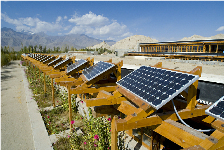
As the school expands and electricity demand increases, we will need to increase installed capacity of both photovoltaic panels and inverters.
Around half of the initial investment in solar energy was co-financed by carbon-offest funds and additional capacity has been installed funded by a travel industry carbon-offset scheme.
We separate bio-degradable waste, which goes into a composting bin in the greenhouse. We aim to boost these activities, work on further separation of waste materials and increase the percentage of recycled waste.

Students from BaSiC Initiative (USA) helped with recycling issues in summer 2009 and produced some comic books to help the kids understand and become motivated. Take a look - download the pdf
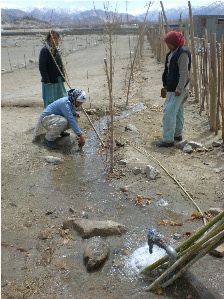
Weather patterns seem to be shifting and glaciers are tending to recede. Therefore water supply could be at risk in some areas in the medium-term.
Our solar pumps raise water from a depth of about 30 metres into above-ground reservoirs at the top of the campus, from where water is distributed under gravity through separate potable and irrigation systems. We use grey (used) water for irrigation, including for willow saplings.
We monitor the situation closely on the Shey campus and water management is becoming more and more important. This reality is being integrated into the learning process.
In this gallery you can find out more about the buildings that make the Druk Padma Karpo School so special.
Here's some background information on our award winning engineering solutions.
Ventilation Improved Pit Latrines
Traditional dry latrines have been enhanced to ‘VIP latrines’. These eliminate fly and odour problems and – most importantly in a desert environment - do not require water. A double chamber system with an integrated solar flue allows their operation as composting toilets and produces humus that can be used as fertiliser.
Passive Solar Heating
Ladakh is hot in summer and very cold in winter. But even in winter, there is often intense sunlight and the teaching spaces heat quickly thanks to their optimal 30° south-east orientation, combined with fully-glazed solar façades that gather the sun’s energy and store heat in high thermal mass walls.
The Residences are oriented due south, and use Trombe Walls, which are coated externally with dark, heat-absorbing material and are faced with a double layer of glass. Heat is stored in the wall and conducted inwards to the dormitories at night-time.
Gravity Feed Water System
Water is a scarce resource in Ladakh. The system pumps snow-melt water from a depth of about 30m to reservoirs near the top of the site. One reservoir provides drinking water under gravity feed to the school, while the other reservoir provides irrigation water. Water availability is a key aspect of the hygiene promotion programme that forms an important part of the education.
Seismic Design and Safety
The major October 2005 earthquake in adjacent Pakistan was a ‘wake-up call’ concerning such risks in Ladakh. Druk Padma Karpo building structures use timber frames to resist seismic load in the event of an earthquake. The post-2010 mudslide repair work on the school buildings includes seismic strengthening work for enhanced safety.

